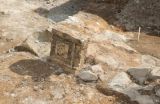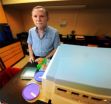(Press-News.org) Archaeologists from the University of Leicester who are leading the search for the lost grave of King Richard III announced today that they have made a new advance in their quest.
They have uncovered evidence of the lost garden of Robert Herrick – where, historically, it is recorded there was a memorial to Richard III.
Now the 'time tomb team' as they have become to be known has discovered paving stones which they believe belong to the garden.
The University of Leicester is leading the archaeological search for the burial place of King Richard III with Leicester City Council, in association with the Richard III Society.
In 1485 King Richard III was defeated at the battle of Bosworth. His body, stripped and despoiled, was brought to Leicester where he was buried in the church of the Franciscan Friary, known as the Grey Friars. Over time the exact whereabouts of the Grey Friars became lost.
The project which began two weeks ago has involved digging of two trenches at a council park- and this week a third trench was excavated. Earlier this week, the archaeologists confirmed they had found the church of the Grey Friars and now they have found the garden outside the church.
Philippa Langley, of the Richard III Society, said: "This is an astonishing discovery and a huge step forward in the search for King Richard's grave. Herrick is incredibly important in the story of Richard's grave, and in potentially helping us get that little bit closer to locating it."
In the early 1600s, Alderman Robert Herrick, a mayor of Leicester, bought the land of the Grey Friars and built a large mansion house with a garden on the site. In 1612, Christopher Wren, father of the famous architect, was visiting Herrick and recorded seeing a handsome three foot stone pillar in Herrick's garden. Inscribed on the pillar was: 'Here lies the body of Richard III sometime King of England'.
This is the last known record of the site of King Richard's grave. Richard is historically recorded as being buried in the choir of the Church of Grey Friars.
Thereafter, in 1711, Herrick's descendants sold the mansion house and garden. After passing through various owners the mansion house was eventually pulled down sometime in the 1870s and the municipal buildings were built. However, Herrick's garden seems to have remained a garden, or wasteland, up until the 1930s - 40s when it was tarmacked over to become a car park.
Mrs Langley added: "The discovery of Herrick's garden is a major step forward and I'm incredibly excited. In locating what looks like one of the garden's pathways and, potentially, its central area which could have once held the three foot stone pillar marking the location of King Richard's grave, we could be that bit closer to finding the resting place of Britain's last warrior king."
Mr Buckley, Co-Director of University of Leicester Archaeological Services, said the area of paving was found at its southern end, composed of re-used medieval tiles laid in a haphazard pattern.
"The tiles were also extremely worn and of many different sizes. Although the date at which the paving was laid has yet to be confirmed, we suspect that it relates to the period of Herrick's mansion. Interestingly, the 18th century map of Leicester shows a formal garden with a series of paths leading to a central point.
"The paving we have found may relate to this garden, but it lies outside the church to the south. Inside the church in this third trench, further investigation has revealed some large fragments of window tracery which could well relate to the east window, behind the high altar. If so, this may show that we are in the extreme east end of the building –near the choir where Richard III is said to have been buried.
"Having overcome the major hurdle of finding the church, I am now confident that we are within touching distance of finding the choir – a real turning point in the project and a stage which, at the outset, I never really thought we might reach."
Work at the site will stop for a public open day between 11- 2 on Saturday September 8 and will resume next week. More details of the public open day here: http://news.leicester.gov.uk/newsArchiveDetail.aspx?Id=1671
The dig is being filmed by Darlow Smithson Productions for a forthcoming Channel 4 documentary to be aired later this year.
INFORMATION:
Notes to editors:
Media resources (including images) available at: http://www2.le.ac.uk/offices/press/media-centre/richard-iii
Images from 'Herrick's garden' can be downloaded from here: https://www.dropbox.com/sh/szg2mzbcfzgedpm/1BUzdMMTeb
Captions:
1 & 2. Fragments of what could be the east end window of the church. Image credit: University of Leicester
3. Lead window came (The H-section leading that supports stained glass windows) from the Grey Friars church. Image credit: University of Leicester
4. Medieval silver penny found at the site. Image credit: University of Leicester
5. Philippa Langley, from the Richard III Society, in Herrick's garden. Image credit: University of Leicester
6. Stone Frieze which may be from the Choir stall. Image credit: University of Leicester
Archaeologists uncover 'lost garden' in quest for Richard III
Public open day at dig site on Saturday 8 September from 11am-2pm
2012-09-07
ELSE PRESS RELEASES FROM THIS DATE:
Premier global health journal, The Lancet, releases series on universal health coverage
2012-09-07
Washington D.C., September 7, 2012 – Every year 100 million people are pushed into poverty because they have to pay for health services directly. With support from the Rockefeller Foundation, Results for Development Institute has partnered with the world's premier global health journal, The Lancet, on a special collection of papers exploring the social, political, and economic issues around the global movement towards universal health coverage (UHC) – defined by the World Health Organization as everyone in a population having access to appropriate, promotive, preventive, ...
Antibiotic therapy improves moderate exacerbations of mild-to-moderate COPD
2012-09-07
Antibiotic treatment with amoxicillin/clavulanate improves moderate exacerbations in patients with mild-to-moderate chronic obstructive pulmonary disease (COPD) and significantly prolongs the time between exacerbations, according to a new study from researchers in Spain.
"The existing evidence for antibiotic therapy in non-severe exacerbations of COPD is weak," said lead author Carl Llor, MD, PhD of the University Rovira i Virgili in Tarragona, Spain. "The results of our multicenter, randomized, double-blind, placebo-controlled trial show that antibiotic treatment is ...
Towards computing with water droplets -- superhydrophobic droplet logic
2012-09-07
Researchers in Aalto University have developed a new concept for computing, using water droplets as bits of digital information. This was enabled by the discovery that upon collision with each other on a highly water-repellent surface, two water droplets rebound like billiard balls.
In the work, published in the journal Advanced Materials, the researchers experimentally determined the conditions for rebounding of water droplets moving on superhydrophobic surfaces. In the study, a copper surface coated with silver and chemically modified with a fluorinated compound was ...
Istanbul -- The earthquake risk of a megacity
2012-09-07
Today the drilling starts for a seismic monitoring network on the Marmara Sea near Istanbul. Specially designed seismic sensors in eight boreholes on the outskirts of Istanbul and around the eastern Marmara Sea will monitor the seismic activity of the region with high precision. In each of the respective 300 meter deep holes several borehole seismometers will be permanently installed at various depths. These detect even barely perceptible earthquakes with very small magnitudes at a high resolution and can thus provide information about the earthquake rupture processes associated ...
University of Toronto scientists cast doubt on renowned uncertainty principle
2012-09-07
TORONTO, ON – Werner Heisenberg's uncertainty principle, formulated by the theoretical physicist in 1927, is one of the cornerstones of quantum mechanics. In its most familiar form, it says that it is impossible to measure anything without disturbing it. For instance, any attempt to measure a particle's position must randomly change its speed.
The principle has bedeviled quantum physicists for nearly a century, until recently, when researchers at the University of Toronto demonstrated the ability to directly measure the disturbance and confirm that Heisenberg was too ...
Ancient, bottom-dwelling critter proves: Newer isn't always better
2012-09-07
BUFFALO, N.Y. -- Tiny sea creatures called rhabdopleurids reside on the ocean floor, building homes of collagen on the shells of dead clams. Rhabdopleurid colonies are small, and the critters are by no means the dominant animals in their ecosystem.
But they have lived this way -- and survived -- for more than 500 million years. And in doing so, they have outlasted more elaborate species that also descended from a common ancestor, according to a new study in the journal Lethaia.
Though rhabdopleurids' age and modern existence are well-documented, the paper breaks new ground ...
Strategy developed to improve delivery of medicines to the brain
2012-09-07
New research offers a possible strategy for treating central nervous system diseases, such as brain and spinal cord injury, brain cancer, epilepsy, and neurological complications of HIV. The experimental treatment method allows small therapeutic agents to safely cross the blood-brain barrier in laboratory rats by turning off P-glycoprotein, one of the main gatekeepers preventing medicinal drugs from reaching their intended targets in the brain.
The findings appeared online Sept. 4 in the Proceedings of the National Academy of Sciences, and is the result of a study from ...
NASA keeping an 'eye' on Hurricane Michael
2012-09-07
Hurricane Michael's eye was so clear on new satellite imagery from NASA that the surface of the Atlantic Ocean could be seen through it.
NASA satellites have provided visible, infrared and microwave imagery of Hurricane Michael as it tracks north in the eastern Atlantic. A stunning visible image of Hurricane Michael was taken by the Moderate Resolution Imaging Spectroradiometer (MODIS) instrument that flies aboard NASA's Aqua satellite on Sept. 6 at 12:20 p.m. EDT. In the image, Michael's eye was so clear that the ocean surface is visible through it. Since that time infrared ...
Stress prompts some to retain as much salt as eating fries
2012-09-07
AUGUSTA, Ga. – When stressed, about 30 percent of blacks hold onto too much sodium, the equivalent of eating a small order of fast food French fries or a small bag of potato chips, researchers say.
"This response pattern puts you under a greater blood pressure load over the course of the day and probably throughout the night as well, increasing your risk of cardiovascular disease," said Dr. Gregory Harshfield, hypertension researcher at the Institute of Public and Preventive Health at Georgia Health Sciences University.
In response to stress, they hold onto about 160 ...
Who's the most influential in a social graph?
2012-09-07
At an airport, many people are essential for planes to take off. Gate staffs, refueling crews, flight attendants and pilots are in constant communication with each other as they perform required tasks. But it's the air traffic controller who talks with every plane, coordinating departures and runways. Communication must run through her in order for an airport to run smoothly and safely.
In computational terms, the air traffic controller is the "betweenness centrality," the most connected person in the system. In this example, finding the key influencer is easy because ...
LAST 30 PRESS RELEASES:
NIH-led study reveals role of mobile DNA elements in lung cancer progression
Stanford Medicine-led study identifies immune switch critical to autoimmunity, cancer
Research Alert: How the Immune System Stalls Weight Loss
Glucagon-like peptide 1 receptor agonist use and vertebral fracture risk in type 2 diabetes
Nonadherence to cervical cancer screening guidelines in commercially insured US adults
Contraception and castration linked to longer lifespan
An old jeweler’s trick could unlock next-generation nuclear clocks
Older age, chronic kidney disease and cerebrovascular disease linked with increased risk for paralysis and death after West Nile virus infection
New immune role discovered for specialized gut cells linked to celiac disease
A new ‘hypertropical’ climate is emerging in the Amazon
Integrated piezoelectric vibration and in situ force sensing for low-trauma tissue penetration
Three-hit model describes the causes of autism
Beech trees use seasonal soil moisture to optimize water uptake
How thinning benefits growth for all trees
Researchers upgrades 3-PG forest model for improved accuracy
Achieving anti-thermal-quenching in Tb3+-doped glass scintillators via dual-channel thermally enhanced energy transfer
Liquid metal modified hexagonal boron nitride flakes for efficient electromagnetic wave absorption and thermal management
Failure mechanisms in PEM water electrolyzers
Study captures how cancer cells hide from brain immune cells, shows that removing their “don’t eat me” signals stops their escape
New breakthrough in detecting ‘ghost particles’ from the Sun
Half of people arrested in London may have undiagnosed ADHD, study finds
From dots to lines: new database catalogs human gene types using ’ACTG’ rules
Persistent antibiotic resistance of cholera-causing bacteria in Africa revealed from a multinational workshop for strengthening disease surveillance
SwRI, Trinity University to synthesize novel compound to mitigate effects of stroke, heart attack
Novel endocrine therapy giredestrant improves disease-free survival over standard of care for patients with early-stage breast cancer in phase III lidERA trial
Gen Z views world as "scary place" with growing cynicism about ability to create change
Biosensor performance doubled – New applications possible
Leveraging incomplete remote sensing for forest inventory
Key chemical in dark chocolate may slow down ageing
New 15-minute hepatitis C test paves the way for same-day treatment
[Press-News.org] Archaeologists uncover 'lost garden' in quest for Richard IIIPublic open day at dig site on Saturday 8 September from 11am-2pm




